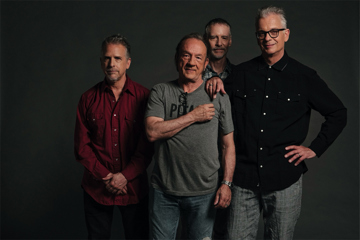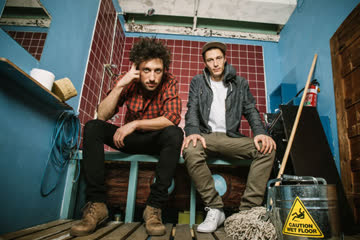Is There Such Thing As A Perfect Setlist?
Gigs have changed a bunch since the early days of live music.

Blink-182 performing live (Credit: Peter Dovgan)

Think back to your first live gig: the lights hit your eyes, you could feel the bass in your body, and you learned a couple new words from the drunk guy standing near you.
It’s pretty safe to say we all have different relationships with gigs nowadays. Our hard-earned funds need to go something worth our while, so we check out if there’s some cool merch offerings, what the venue’s like, and even setlists so we can learn every word.
When did the setlist become such a pillar of the live gig? Check out fan accounts on Instagram and you’ll be swamped with lists and discussions on a band’s set – why this song wasn’t played, why the encore was a bad choice, even complaints about why new songs were played.
Is there such thing as the perfect setlist? Let’s investigate.
Gigs have changed a bunch since the early days of live music. We’ve got devices in our fingers that can virtually bring us any live video of any band performing any one of their songs. Back in the day, fans could never immerse themselves in an act like we do in 2024. With parasocial relationships on the rise, a lot of us tend to connect to our favourite musos a bit differently – we’ll try anything to snap a pic with them, chuck a vid of their hit on TikTok, or even try to nab a setlist from one of the stagehands after the gig’s over.
Artists have changed a lot too. For any band hitting our arenas or big stages, you’ll rarely see them hit the stage, play the songs, and leave. There will be pyro, lights, and banter you’ll feel is made especially for you.
Don't miss a beat with our FREE daily newsletter
At the end of the day, it’s impossible for a big name to have a setlist that perfectly pleases everyone in attendance – unless you’re Taylor Swift with a three-and-a-half-hour salute to your entire discography, it’s pretty hard to find something to keep the masses happy.
With artists like Swift, Matchbox Twenty, blink-182, P!nk and Sampha recently hitting our shores, our stages are full of big names here in support of new records. With a hallmark act, the new songs never have as much time to ruminate as the classics. Even if you’re a fan of the new stuff, there’s always a little voice screaming, “I just want to hear the hits,” or “I haven’t listened to the new album properly yet.” But do new songs impact the quality of a setlist?
Artists are always going to play new songs, but the skill is placement in the setlist. Even for the biggest acts on the planet, new tracks always have the ability to lose a crowd. So if a new track kicks off the set, you’ll always find it followed up with a classic. Just look at Matchbox Twenty’s recent Aussie sets. They opened with Friends, a new track, followed by their showstopper How Far We’ve Come.
Other performers (like recent visitors blink-182 and Pink) litter the first section of their shows with classics before chucking in a track off their latest release. This allows them to build up a bit of momentum and rapport with the crowd, before potentially losing a bit of it when a new song hits.
Whatever the case, there will always be the hits. For the acts we’re discussing in this context, you’ll usually find a handful of songs that’ll get the crowd going crazy. But where can they be placed for the most value?
These are the kind of tracks that get the phone screens out — the ones that litter your for-you pages and Instagram feed for days after. Whether it’s blink’s All The Small Things, Swift’s Shake It Off, or Matchbox Twenty’s 3AM, these songs have lives of their own. They’ve been out there for so long, people correlate them with significant parts of their own lives.
When a band you saw live played their biggest hit, it took you back to a certain place or point in time, right? Maybe it was the song you had your first kiss to, or maybe the song that always gets you out of a funk?
These tracks can never be ignored in a setlist. They’re the reason fans come, the reason you can go viral for a night, and the thing that can take a show from great to unforgettable. That’s why you’ll often see the last 20 to 30 minutes of a set dedicated to these classic tracks – if a set lost you with the new tracks, it’ll always win with a string of songs you know every word to.
In this era, and especially post-COVID, it’s hard to get people’s attention. With attention spans dropping and people staying in a little more, a lot of artists are driving towards shows that offer more of an experience.
A few artists have realised this and added somewhat of a drawcard to their setlists, with either unplanned/surprise songs or a spot that’ll see them rotate between a selection of special songs each night. This has been seen across the world with artists like John Mayer, the Jonas Brothers and Maisie Peters.
Perhaps most notably, the monolith Swift has dedicated two setlist spots for surprise songs. Chucking this in the middle of the night means there’s no middle-of-the-set-lull – it’s the perfect solution for those diehards screaming for that one deep-cut they haven’t heard live in years.
The final song of the night can be one of the toughest elements of a setlist. This is the last chance an artist has to wow the crowd, so unless you’re seeing someone like Prince, this will very rarely be a B-side or cover. It should be an artist’s breakout single or biggest hit. This will leave audiences with a smile on their face – the first symptom of post-concert depression.
Setlists for big acts are always tough, and it’s virtually impossible to appeal to every fan in this day and age. But when the show opens and closes with a hit, a few new tracks are littered in the middle, and maybe there’s a song or two thrown in just for those lifelong fans, you’re definitely on the way to a perfect setlist.







